Daily News Staff Writer
Courtesy of the New York Daily News
Queens, the city’s largest borough, historically has attracted an eclectic mix of iconic artists, athletes and thinkers.
But you wouldn’t know that by counting its landmarks.
That may change in the wake of a city-commissioned survey of 12,495 buildings in Queens, which has the fewest stand-alone landmarks – 69 – of any borough, just a tenth of Manhattan’s.
That survey could be vital in saving the borough’s heritage at a time when a building boom is sweeping across Queens.
“It gives us an opportunity to focus on more designations where they’re warranted, and also to get ahead of the curve on any buildings that may be endangered,” said Landmarks Commission Chairman Robert Tierney.
Queens preservationists have been critical of the commission, but remain cautiously optimistic about the survey.
However, they fear some noteworthy, at-risk sites won’t win designations, given the commission’s record of favoring architecture over historical significance.
With that in mind, Queens News is kicking off a “History in Peril” series – offering profiles of unlandmarked sites.
To be declared a city landmark, according to the guidelines, a structure must be at least 30 years old and possess “a special character or special historical or aesthetic interest or value as part of the development, heritage or cultural characteristics of the city, state or nation.”
Once a landmark is designated by the commission and approved by the City Council, the building owner needs the commission’s consent to change the facade or significant architectural features.
Income-eligible owners can also apply for upkeep grants.
With such protections, landmark designation is the surest way to maintain a historic gem, preservationists contend.
“Areas throughout the city feel the development pressure,” said Peg Breen, president of the New York Landmarks Conservancy. “It’s crucial to get ahead of the game a little bit.”
Queens Historical Society President Jim Driscoll said the survey will lead to designations – but “maybe not the ones we want or as many as we want.”
He criticized the mayoral-appointed, 11-member commission – three architects, a historian, a Realtor, a planner or landscape artist and reps from each borough – for ignoring Queens.
Nancy Cataldi, president of the Richmond Hill Historical Society, said the agency hasn’t been eager to consider local sites. “It’s very frustrating,” she said. “They’re not listening.”
Others gripe the commission relies too much on the City Council – perhaps by necessity, since the Council gets final say on designations.
In 2005, when preservationist Michael Perlman pushed for designation of the Art Deco-style Trylon Theater in Forest Hills, Tierney sought approval from local Councilwoman Melinda Katz.
But Katz didn’t take a position on the movie house, and the commission shot the effort down. Crews gutted and renovated the Trylon into a Bukharian Jewish center.
Recent years, however, have brought promise.
Since Mayor Bloomberg took office in 2002, the commission has designated 661 Queens structures, including those in historic districts. In February, it landmarked a Corona synagogue and former Jamaica bank.
“The idea that some say we’re either neglecting Queens or something, Queens is not getting the attention the rest of the city gets, is not borne out by these facts,” Tierney said.
Moving forward, the best way to get a Queens site landmarked is to highlight its role in the community, said Simeon Bankoff, executive director of the Historic Districts Council.
“Buildings don’t exist in a vacuum,” he said.
































